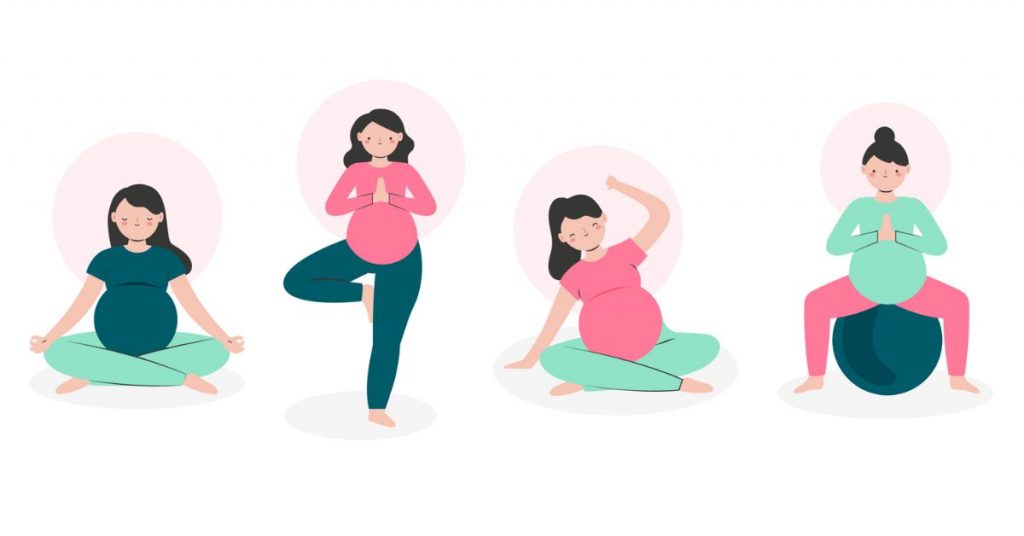Prenatal Yoga: A Perfect Pregnancy Exercise
Prenatal Yoga: A Perfect Pregnancy Exercise
A great method to do both is through prenatal yoga. Yoga provides an opportunity to settle down and establish a connection with your baby and your changing body, which is much needed in today’s hectic environment. You can benefit from the various advantages of yoga during pregnancy whether you are a novice or an experienced practitioner.
Introduction
Pregnancy is a transformative journey marked by physical and emotional changes. Among the various ways to support a healthy pregnancy, prenatal yoga emerges as a holistic practice that not only enhances physical well-being but also cultivates mental and emotional balance. In this comprehensive blog, we will delve into the world of prenatal yoga, exploring its benefits, safety considerations, recommended poses, and the profound impact it can have on both the expecting mother and the growing baby.
It is a specialized form of yoga designed to cater to the unique needs and changes experienced by pregnant women. It focuses on promoting physical, mental, and emotional well-being during pregnancy and prepares expectant mothers for childbirth. Prenatal yoga classes typically incorporate modified yoga poses, breathing exercises, and meditation techniques that are safe and beneficial for pregnant women.
Key features of prenatal yoga include
- Gentle Yoga Poses: Prenatal yoga poses are adapted to accommodate the changing body of a pregnant woman. The emphasis is on gentle stretches, strengthening exercises, and poses that promote flexibility without putting undue stress on the joints.
- Breathing Techniques: Prenatal yoga places significant emphasis on breathwork, teaching women to use their breath to relax, manage stress, and prepare for labor. Controlled and mindful breathing techniques are often integrated into the practice.
- Pelvic Floor Exercises: Strengthening the pelvic floor muscles is crucial during pregnancy and for postpartum recovery. Prenatal yoga often includes exercises to engage and tone these muscles, aiding in childbirth and preventing certain postpartum issues.
- Meditation and Relaxation: Prenatal yoga classes typically include relaxation and meditation components. These practices help reduce stress, promote emotional well-being, and create a positive mindset for the expecting mother.
- Community Support: Prenatal yoga classes provide a supportive community where pregnant women can connect with each other, share experiences, and build a sense of camaraderie. This supportive environment can be beneficial for emotional well-being during pregnancy.
- Professional Guidance: Certified prenatal yoga instructors lead these classes, ensuring that the practices are safe and appropriate for the various stages of pregnancy. Instructors often provide modifications for different trimesters and individual needs.
How is prenatal yoga different from regular yoga?
When you’re pregnant, common yoga poses, including those where your feet are far apart, could be too taxing on your joints and pelvis. The weight of your growing child is exerting increased pressure on your pelvis and bladder.
Pregnancy Hormones further relax your ligaments, causing joint and bone issues—particularly those involving the pubic bone—to cause discomfort. Prenatal yoga includes breathing, stretches, and strengthening exercises that assist your body get ready for labor in addition to positional modifications for expectant mothers.
Can prenatal yoga be the first time I ever do yoga?
Embracing the prenatal yoga trend doesn’t need you to be a yoga practitioner before becoming pregnant. For all expecting mothers, yoga is the perfect activity, provided that your doctor has given the all-clear to continue physical activity during your pregnancy: Because it is mild and intended for use throughout pregnancy, it aids in preparing you for the psychological elements of giving birth (and after).
But keep in mind that it’s wise to see your healthcare provider before beginning any new workout regimen while you’re pregnant.
What to expect in a pregnancy yoga class
You’ll probably be urged to utilize props (bolsters, blocks, wedges, or folded blankets) in a prenatal yoga class in order to get the right alignment. Generally speaking, you can anticipate:
- An overview: Your name, your pregnancy status, the locations of any aches and pains, and the body regions or poses you would want to focus on are all important details for your yoga instructor to know. During this period, you should be able to socialize with other mothers: Many studios urge mothers to share a little bit of their pregnancy experiences with the group before class begins, including anxieties, hopes, and dreams. Most studios also encourage their students to converse before and after class.
- A brief moment of relaxation: The practice starts with a brief moment of relaxation and introspection, just like conventional vinyasa classes do (a practice you might find valuable during labour).
- A brief warm-up: Your muscles and joints will become ready for class as you gradually begin to move your body.
- A yogic flow did standing: Along with hip and chest opening poses, this will include pelvic floor and abdominal toning exercises. Deep, diaphragmatic breathing—as opposed to the shallow, Lamaze-associated “hee-hee-hoo-hoo” breathing—will be emphasized throughout. Most of the poses you do will be similar to what you would do in a typical vinyasa session; they will only be adjusted to ensure your safety.
- Gentle Stretching: To further extend and relax your muscles, your teacher will guide you through a few stretches. This ought to be comfortable!
- An Adaptation of the Savasana: Your teacher will instruct you to relax in “savasana,” which is lying on your back with your eyes closed, after all of your hard effort.
- A Modification of Savasana: You would lie on your side with a bolster and blanket for support in the third trimester, or on your back with a bolster to raise your upper body at a 45-degree angle in the second trimester. You should be able to maintain this posture for six or seven minutes. It’s a serene stance meant to promote complete relaxation.

The Benefits of Prenatal Yoga
1. Physical Well-being:
Prenatal yoga provides gentle yet effective exercises that focus on strengthening the muscles crucial for labor and delivery. It promotes flexibility, balance, and posture, alleviating common discomforts associated with pregnancy such as back pain and swollen ankles.
2. Emotional and Mental Balance:
The mind-body connection in yoga is especially beneficial during pregnancy. Prenatal yoga incorporates mindfulness and breathwork, offering expecting mothers a valuable toolkit for managing stress, anxiety, and mood swings. These practices contribute to a more positive emotional state throughout pregnancy.
Certain prenatal yoga poses and breathing techniques are designed to enhance the mother’s endurance and stamina, preparing her both mentally and physically for the challenges of labor. The focus on controlled breathing aids in relaxation, an invaluable skill during childbirth.
4. Bonding with the Baby:
Prenatal yoga fosters a sense of connection between the mother and the baby. Through mindful movements and meditation, expecting mothers can create a serene environment that positively influences the baby’s development and establishes a deeper bond.
Safety Considerations: Practicing Prenatal Yoga with Caution
While prenatal yoga is generally safe and beneficial, certain precautions should be taken to ensure the well-being of both the mother and the baby:
1. Consultation with Healthcare Provider:
Before beginning any prenatal exercise routine, it’s crucial for expecting mothers to consult with their healthcare providers. This ensures that the chosen yoga practice aligns with their individual health conditions and the specific needs of their pregnancy.
2. Expert Guidance:
Attending prenatal yoga classes led by certified instructors experienced in working with pregnant women is highly recommended. These instructors can provide modifications for poses, ensuring a safe and comfortable practice tailored to the changing needs of the body during pregnancy.
3. Avoiding Certain Poses:
Certain yoga poses, such as deep twists or those involving lying on the back for extended periods, may not be suitable during pregnancy. Awareness of contraindicated poses and modifications is essential to prevent any potential harm.
Recommended Prenatal Yoga Poses: Nurturing the Body
This foundational pose helps improve posture, strengthen the legs, and enhance overall body awareness.
2. Cat-Cow Stretch:
A gentle flow between these poses promotes flexibility in the spine and alleviates back pain.
3. Sukhasana (Easy Pose):
This comfortable seated pose encourages relaxation and can be enhanced with mindfulness and breathing exercises.
4. Warrior II:
Strengthening the legs and opening the hips, Warrior II is a beneficial pose for building endurance.
5. Pelvic Floor Exercises:
Specific exercises targeting the pelvic floor help prepare these muscles for labor and promote postpartum recovery.
The Impact of Prenatal Yoga on the Mind: A Journey Within
1. Mindfulness and Stress Reduction:
Prenatal yoga emphasizes mindfulness through breath awareness and meditation, providing tools for managing stress and promoting a calm state of mind.
2. Emotional Resilience:
The practice of prenatal yoga fosters emotional resilience, enabling expecting mothers to navigate the emotional ups and downs of pregnancy with greater ease.
3. Improved Sleep Quality:
The relaxation techniques incorporated in prenatal yoga contribute to better sleep quality, a crucial aspect of overall well-being during pregnancy.
Conclusion- Prenatal Yoga: Accepting the Journey
To sum up, prenatal yoga is a life-changing discipline that supports expectant moms’ physical and emotional health. Prenatal yoga offers a comprehensive approach to pregnancy with its gentle yet effective poses, mindfulness practices, and emphasis on breathwork, helping women to handle the significant changes with grace and strength. Prenatal yoga is a technique for self-care and preparing for childbirth. It helps women have healthier pregnancies and have a pleasant, empowered transition into motherhood. Embracing prenatal yoga may be a deep and fulfilling part of your pregnancy journey, regardless of your level of experience.
The benefits of prenatal yoga include improved physical fitness, enhanced flexibility, better posture, reduced stress and anxiety, improved sleep, and increased body awareness. Additionally, practicing prenatal yoga may help with pain management during labor and contribute to a smoother postpartum recovery.
It’s essential for pregnant women to consult with their healthcare providers before starting any exercise program, including prenatal yoga, to ensure that it aligns with their individual health conditions and specific needs. Prenatal yoga can be a valuable tool for women seeking a holistic approach to maintaining their well-being throughout the journey of pregnancy.
Frequently Asked Questions (FAQs)
-
What is prenatal yoga?
Prenatal yoga is a specialized form of yoga designed for pregnant women to promote physical, mental, and emotional well-being during pregnancy. It involves gentle poses, breathing exercises, and meditation tailored to the unique needs of expectant mothers.
-
Is it safe to practice prenatal yoga during all trimesters of pregnancy?
In general, prenatal yoga is safe for most pregnant women, but it’s essential to consult with a healthcare provider before starting any exercise routine. Certified prenatal yoga instructors often provide modifications for different trimesters to ensure safety.
-
What are the benefits of prenatal yoga?
Prenatal yoga offers numerous benefits, including improved flexibility, strength, and balance. It helps alleviate common pregnancy discomforts, enhances relaxation, reduces stress, and provides tools for better pain management during labor.
-
Can I practice prenatal yoga if I’m new to yoga or not very flexible?
Prenatal yoga is suitable for beginners and all fitness levels. Certified instructors can tailor the practice to accommodate individual needs and limitations, ensuring a safe and enjoyable experience.
-
Are there specific poses to avoid during prenatal yoga?
Certain yoga poses, such as deep twists and poses involving lying flat on the back for an extended period, are generally advised against during pregnancy. A qualified prenatal yoga instructor can guide participants on modifications and suitable alternatives.
-
When is the best time to start prenatal yoga?
Women can start prenatal yoga as soon as they feel comfortable, and many begin in the first trimester. However, it’s advisable to wait until after the first trimester, especially if there are any pregnancy-related complications. Always consult with a healthcare provider before starting.
-
Can prenatal yoga help with labour and delivery?
Yes, prenatal yoga can be beneficial for labor and delivery preparation. The practice focuses on strengthening the pelvic floor, improving endurance, and teaching effective breathing techniques, all of which can contribute to a smoother childbirth experience.
-
Do I need any special equipment for prenatal yoga?
While a yoga mat is helpful, you generally don’t need any special equipment. Comfortable clothing that allows for movement is recommended. Some women might find props like blocks or bolsters useful for support in certain poses.
-
How often should I practice prenatal yoga?
The frequency of prenatal yoga practice varies for each individual. Most women find benefit in practicing a few times a week. Regularity is more important than intensity, and it’s crucial to listen to the body and adjust the practice accordingly.











